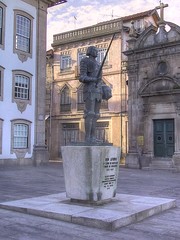Frans Harren ha aggiunto una foto al pool:
Afonso I of Portugal, Duke of Braganza (Fronteira, Cabeço de Vide, 10 August 1377 – Chaves, 15 December 1461) was the eighth Count of Barcelos, the 2nd Count of Neiva and 2nd Lord of Faria and the first Duke of Braganza.
Historians believe he was born in Veiros, Estremoz, Alentejo, as a natural son of Portuguese King John I and Inês Peres. He married Beatriz Pereira de Alvim, daughter of Nuno Álvares Pereira, general of the kingdom, and heir of the most opulent house of the kingdom.<
A traveled and cultivated man, Afonso was present in 1415 when the Portuguese conquered Ceuta. When his half-brother Edward I, King of Portugal died in 1438, his son Afonso V (Afonso’s nephew) was an infant and the choice for the regency was the Queen-Mother Leonor of Aragon (Afonso’s sister-in-law). This choice for the regency was not popular because Leonor was Aragonese, so in a reunion of the Cortes, summoned by Afonso’s half-brother John, Duke of Aveiro, another half-brother of Afonso, Pedro, was appointed as Regent of the Kingdom during the minority of his nephew Afonso V, a choice that pleased both the people and the fast-growing Bourgeoisie.
However, inside the Portuguese aristocracy, especially the ones around Afonso, Count of Barcelos, Leonor of Aragon was preferred and there were doubts about Pedro political hability. A war of influences started and few years later Afonso managed to become young King Afonso V’s favourite uncle.
In 1443, in a gesture of reconciliation, Pedro made Afonso the first Duke of Braganza and the relations between both seemed to return to normality. But, in 1445, Afonso took offence because Isabel of Coimbra, Pedro’s daughter was the choice for Afonso V’s wife, and not one of her daughters. Indifferent to the intrigues, Pedro continued his regency and the country prospered under his influence. It was during this period that the first subsidies for the exploration of the Atlantic Ocean were implemented, and the organization was given to Henry the Navigator (Another of Afonso’s half-brothers).
On June 9, 1448, King Afonso V came of age and Pedro gave the control of the country to the king. Influenced by Afonso, Count of Barcelos, and recently Duke of Braganza, Afonso V nulifies all Pedro’s edicts.
The following year, under accusations that years later would prove false, Afonso V declared his uncle Pedro, Duke of Coimbra a rebel. The situation became unsustainable and a civil war begun. It was short because on May 20, 1449, during the Battle of Alfarrobeira, near Alverca, Pedro, Duke of Coimbra died. The exact conditions of his death are debatable: some say it was in combat, other say he was assassinated by one of his own men.
After the Battle of Alfarrobeira, Afonso V gave new powers to the Duke of Braganza and nine years later when he departed to Africa, the regency was delegated to Afonso.
Chaves is a town and seat of municipality in the far North of Portugal, 10 km south of the Spanish border and 22 km south of Verín, Spain. The municipality is the second most populous of the district of Vila Real. The district capital, Vila Real, is 60 km south on the A24 toll-free motorway. Aquæ Flaviæ was the Roman name for this town.
The town has always had great historical importance, being the site of an important Roman garrison and later being in the forefront of resistance during the Napoleonic invasions of the early nineteenth century. In Portuguese military history Chaves is especially famous for two battles: the siege of Chaves by French forces in 1807 and the Royalist attack on Chaves led by Henrique Paiva Couceiro in 1912.
Chaves is a town of fortifications. There is a medieval castle and two forts, Forte São Francisco and Forte São Neutel, both built in the 17th century. Nearby, two medieval fortifications still exist – the Santo Estêvão Tower, in the plain, and the Monforte Castle, in the mountains. The original Roman bridge in Chaves crossing the Tâmega River still stands with its stone arches and is the most important tourist site of Chaves. The hot thermal water (73 degrees Celsius) of Chaves have been famous since Roman times and today many people come to the town (health tourism) to take the water cure in a renewed house and modern thermal complex.
